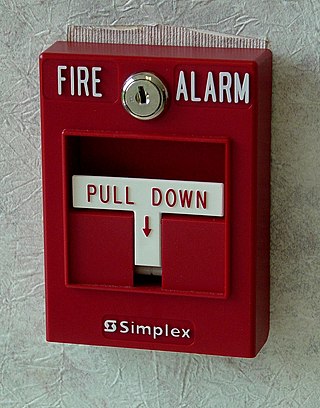
British Standards (BS) are the standards produced by the BSI Group which is incorporated under a royal charter and which is formally designated as the national standards body (NSB) for the UK. The BSI Group produces British Standards under the authority of the charter, which lays down as one of the BSI's objectives to:
Set up standards of quality for goods and services, and prepare and promote the general adoption of British Standards and schedules in connection therewith and from time to time to revise, alter and amend such standards and schedules as experience and circumstances require.

A smoke detector is a device that senses smoke, typically as an indicator of fire. Smoke detectors/Alarms are usually housed in plastic enclosures, typically shaped like a disk about 125 millimetres (5 in) in diameter and 25 millimetres (1 in) thick, but shape and size vary. Smoke can be detected either optically (photoelectric) or by physical process (ionization). Detectors may use one or both sensing methods. Sensitive alarms can be used to detect and deter smoking in banned areas. Smoke detectors in large commercial and industrial buildings are usually connected to a central fire alarm system.

Fire control is the practice of reducing the heat output of a fire, reducing the area over which the fire exists, or suppressing or extinguishing the fire by depriving it of fuel, oxygen, or heat. Fire prevention and control is the prevention, detection, and extinguishment of fires, including such secondary activities as research into the causes of fire, education of the public about fire hazards, and the maintenance and improvement of fire-fighting equipment.

Manual fire alarm activation is the process of triggering a fire alarm through a call point, pull station, or other device. This usually causes the alarm to sound the evacuation signal for the relevant building or zone. Manual fire alarm activation requires human intervention, as distinct from automatic fire alarm activation such as that provided through the use of heat detectors and smoke detectors. It is, however, possible for call points/pull stations to be used in conjunction with automatic detection as part of the overall fire detection and alarm system. Systems in completed buildings tend to be wired in and include a control panel. Wireless activators are common during construction.

A fire blanket is a safety device designed to extinguish incipient (starting) fires. It consists of a sheet of a fire retardant material that is placed over a fire in order to smother it.

The Kitemark is a UK product and service quality trade mark which is owned and operated by the British Standards Institution.
Information security standards are techniques generally outlined in published materials that attempt to protect a user's or organization's cyber environment. This environment includes users themselves, networks, devices, all software, processes, information in storage or transit, applications, services, and systems that can be connected directly or indirectly to networks.
Fire protection is the study and practice of mitigating the unwanted effects of potentially destructive fires. It involves the study of the behaviour, compartmentalisation, suppression and investigation of fire and its related emergencies, as well as the research and development, production, testing and application of mitigating systems. In structures, be they land-based, offshore or even ships, the owners and operators are responsible to maintain their facilities in accordance with a design-basis that is rooted in laws, including the local building code and fire code, which are enforced by the authority having jurisdiction.
Active fire protection (AFP) is an integral part of fire protection. AFP is characterized by items and/or systems, which require a certain amount of motion and response in order to work, contrary to passive fire protection.

A fire alarm system is a building system designed to detect, alert occupants, and alert emergency forces of the presence of fire, smoke, carbon monoxide, or other fire-related emergencies. Fire alarm systems are required in most commercial buildings. They may include smoke detectors, heat detectors, and manual fire alarm activation devices. All components of a fire alarm system are connected to a fire alarm control panel. Fire alarm control panels are usually found in an electrical or panel room. Fire alarm systems generally use visual and audio signalization to warn the occupants of the building. Some fire alarm systems may also disable elevators, which are unsafe to use during a fire under most circumstances.
Kidde is a brand subsidiary of Carrier Global that manufactures and distributes fire detection and suppression equipment, as well as smoke and CO alarm units. Kidde is one of America's largest manufacturers of smoke alarms and fire safety products. Kidde is headquartered in Mebane, North Carolina.
The Federation of Environmental Trade Associations (FETA) is a UK body which represents the interests of manufacturers, suppliers, installers and contractors within the refrigeration, heating, ventilating, and air conditioning industry. It is based in Hare Hatch near Wokingham.

The British Standards Institution (BSI) is the national standards body of the United Kingdom. BSI produces technical standards on a wide range of products and services and also supplies standards certification services for business and personnel.

Automatic fire suppression systems control and extinguish fires without human intervention. Examples of automatic systems include fire sprinkler system, gaseous fire suppression, and condensed aerosol fire suppression. When fires are extinguished in the early stages loss of life is minimal since 93% of all fire-related deaths occur once the fire has progressed beyond the early stages.
The EN 54 Fire detection and fire alarm systems is a series of European standards that includes product standards and application guidelines for fire detection and fire alarm systems as well as voice alarm systems.
The Motor Industry Software Reliability Association (MISRA) is an organization that produces guidelines for the software developed for electronic components used in the automotive industry. It is a collaboration between numerous vehicle manufacturers, component suppliers and engineering consultancies.

The Pyrene Company Limited from their beginning in 1914, until 1971 when they became Chubb Fire Security Limited, were among the world's leaders in the manufacture of fire fighting equipment. The name Pyrene was epitomised by their famous 'pump' extinguisher which was installed on public transport, commercial and private vehicles throughout the western world.

An optical beam smoke detector is a device that uses a projected beam of light to detect smoke across large areas, typically as an indicator of fire. They are used to detect fires in buildings where standard point smoke detectors would either be uneconomical or restricted for use by the height of the building. Optical beam smoke detectors are often installed in warehouses as a cost-effective means of protecting large open spaces.
BS 5839 Part 1Fire detection and fire alarm systems for buildings – Part 1: Code of practice for design, installation, commissioning and maintenance of systems in non-domestic premises is a standard published by the British Standards Institution. BS 5839-1:2013 supersedes BS 5839-1:2002+A2:2008, which has been withdrawn. It s the first of 9 parts in a series on national standards relating to fire alarms.










